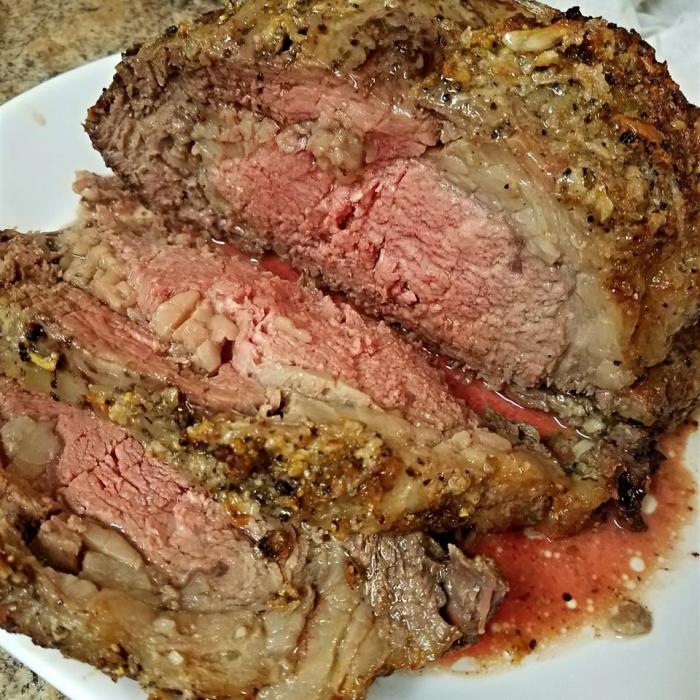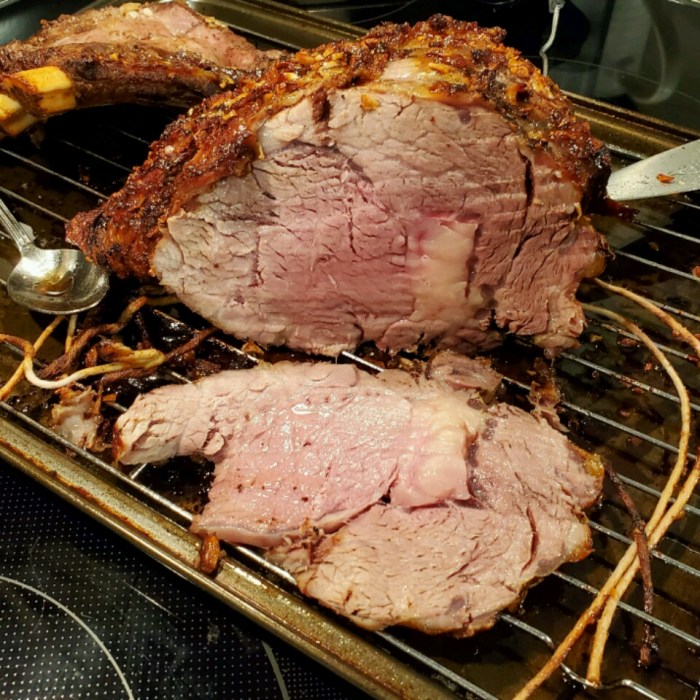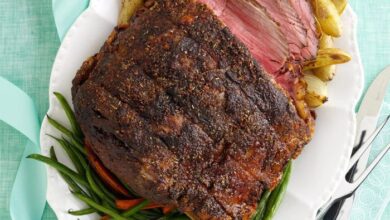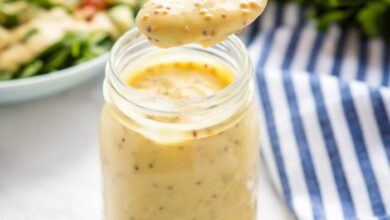
Easy Rib Eye Roast: Mastering the Perfect Cut
Easy Rib Eye Roast: The name alone evokes images of juicy, flavorful meat, and the promise of a delicious meal. This cut of beef, known for its rich marbling and tender texture, is a favorite for both seasoned cooks and those new to the kitchen.
Whether you’re planning a special occasion dinner or simply craving a satisfying weeknight meal, a rib eye roast is a surefire way to impress.
From choosing the right cut to mastering the perfect roasting technique, this guide will equip you with the knowledge and confidence to create a succulent rib eye roast that will leave your taste buds singing. We’ll explore the different grades of rib eye, discuss the best roasting methods, and offer tips for achieving a perfectly cooked and flavorful result every time.
Understanding Rib Eye Roast: Easy Rib Eye Roast
The rib eye roast, a cut of beef prized for its rich flavor and tender texture, is a culinary staple for both casual and formal dining experiences. Its popularity stems from its exceptional marbling and unique flavor profile, making it a favorite among meat enthusiasts.
Rib Eye Roast Characteristics
The rib eye roast is a cut from the rib primal, specifically the 6th through 12th ribs. It’s known for its distinctive marbling, which refers to the intramuscular fat dispersed throughout the meat. This marbling contributes significantly to the rib eye’s juicy and flavorful qualities.
As the fat melts during cooking, it infuses the meat with a rich, savory flavor.
Rib Eye Roast Grades
The quality of a rib eye roast is determined by its grade, which reflects the amount of marbling present. The United States Department of Agriculture (USDA) assigns grades to beef based on its marbling, age, and other factors. The most common grades for rib eye roasts are:
- Select: This grade has the least amount of marbling, resulting in a leaner and less flavorful cut.
- Choice: This grade offers a moderate level of marbling, providing a balance of flavor and tenderness.
- Prime: This grade has the highest amount of marbling, delivering the most intense flavor and juiciness. Prime rib eye roasts are considered the premium choice for a luxurious dining experience.
The higher the grade, the more marbling is present, leading to a more flavorful and tender roast. However, it’s important to note that personal preferences play a role in choosing the right grade. Some individuals may prefer a leaner cut, while others may seek the rich flavor of a heavily marbled roast.
Rib Eye Roast History
The rib eye cut has a rich history, dating back to ancient times. It was highly prized by butchers and chefs for its exceptional flavor and tenderness. In the early days, the rib eye was often served as a whole roast, typically cooked over an open fire.The rib eye roast gained popularity in the United States in the early 20th century, as refrigeration and transportation technologies improved, making it easier to distribute high-quality cuts of beef.
Today, the rib eye roast is a staple in many culinary traditions around the world, enjoyed for its versatility and delicious flavor.
Choosing the Right Rib Eye Roast

The heart of any successful rib eye roast lies in choosing the right cut. It’s a journey that involves considering factors like size, weight, and appearance, along with understanding the nuances of bone-in versus boneless options. This guide will equip you with the knowledge to make an informed choice, leading to a truly memorable meal.
Understanding Different Cuts
The cut of your rib eye roast significantly influences its flavor, tenderness, and cooking time. Bone-in and boneless rib eye roasts offer distinct advantages and considerations:
- Bone-in Rib Eye Roasts: These cuts offer a more robust flavor and enhanced tenderness due to the bone’s presence. They also tend to be more visually appealing, adding a rustic charm to your presentation. However, they require a slightly longer cooking time and might necessitate more precise temperature monitoring due to the bone’s heat-absorbing properties.
- Boneless Rib Eye Roasts: Boneless cuts provide greater versatility in terms of carving and serving. They also offer a more even cooking experience, as the lack of bone eliminates any potential heat disparities. However, they may lack the rich flavor and tenderness associated with bone-in roasts.
Determining the Ideal Size
The size of your rib eye roast depends on the number of servings you plan to prepare. A general guideline for determining the appropriate size is:
- For 2-4 servings: Opt for a rib eye roast weighing 2-3 pounds.
- For 4-6 servings: Choose a roast weighing 3-4 pounds.
- For 6-8 servings: Select a roast weighing 4-5 pounds.
These are merely estimations, and the actual serving size may vary depending on individual appetites and the presence of other dishes on your menu.
An easy rib eye roast is always a crowd-pleaser, but sometimes you need a little extra oomph. That’s where a dollop of spicy salami spread nduja comes in. The spread adds a kick of heat and a rich, savory flavor that takes your roast to the next level.
Just imagine the combination of tender, juicy meat and that fiery, spreadable goodness – it’s a match made in culinary heaven!
Visual Clues for Quality
When selecting a rib eye roast, pay attention to these visual cues:
- Marbling: Look for roasts with good marbling, which refers to the presence of intramuscular fat streaks throughout the meat. This fat contributes to flavor and tenderness, resulting in a more succulent and juicy roast.
- Color: A good rib eye roast should have a rich, deep red color. Avoid roasts that appear pale or have a grayish hue, as this may indicate poor quality or aging.
- Texture: The meat should feel firm and springy to the touch. Avoid roasts that feel mushy or overly soft, as this may suggest improper handling or storage.
Remember, a high-quality rib eye roast is an investment in a delicious and memorable meal. By understanding the factors discussed above, you can make an informed choice and elevate your culinary experience.
A perfectly cooked rib eye roast is a true culinary masterpiece, and while it’s a delicious centerpiece, sometimes you crave something lighter and faster. That’s when I turn to a vibrant asian beef and vegetable stir fry for a satisfying and flavorful meal.
The quick cooking time and medley of fresh vegetables make it a perfect complement to a hearty roast, offering a delightful balance of textures and tastes.
Preparing the Rib Eye Roast
The key to a perfect rib eye roast lies in proper preparation. It’s about setting the stage for a flavorful and tender outcome. This involves a few essential steps that we’ll cover in detail.
Trimming and Tying the Rib Eye Roast
Trimming excess fat from the rib eye roast is important for even cooking and preventing a greasy outcome. It also helps to ensure a more visually appealing presentation. Tying the roast helps maintain its shape during cooking, ensuring even cooking and preventing the roast from becoming misshapen.
- Trim the fat:Use a sharp knife to trim away any excess fat, leaving a thin layer of fat (about ¼ inch) for flavor and moisture.
- Tie the roast:Using butcher’s twine, tie the roast at 1-inch intervals to keep it compact and prevent it from unraveling during cooking.
Seasoning the Rib Eye Roast
Seasoning is where you infuse the rib eye roast with the flavors that will tantalize your taste buds. You can choose from a simple salt and pepper combination to more complex rubs and marinades.
An easy rib eye roast is a crowd-pleaser, but it’s crucial to have the right tools. My go-to for flipping and maneuvering that beautiful piece of meat is the m kitchen world silicone spatula set sale amazon. These spatulas are heat-resistant and flexible, making them perfect for lifting and transferring the roast without damaging the delicate crust.
Different Marinades and Rubs for Rib Eye Roast
- Simple Salt and Pepper:This classic combination allows the natural flavor of the rib eye to shine through. Use kosher salt and freshly ground black pepper for optimal results.
- Garlic and Herb Rub:A blend of garlic powder, onion powder, dried herbs like rosemary, thyme, and oregano, and a touch of paprika adds a savory and aromatic dimension to the roast.
- Spicy Rub:For a kick, incorporate chili powder, cayenne pepper, cumin, and smoked paprika. Adjust the amount of chili powder and cayenne pepper to suit your desired heat level.
- Wine Marinade:A simple red wine marinade with garlic, onion, and fresh herbs like rosemary and thyme adds depth and complexity to the flavor.
- Soy-Ginger Marinade:For a savory and slightly sweet flavor, marinate the rib eye in a mixture of soy sauce, ginger, garlic, and honey.
Searing the Rib Eye Roast
Searing the rib eye roast before roasting is crucial for developing a delicious crust and locking in the juices. It creates a beautiful caramelized exterior that adds depth and complexity to the flavor.
- Preheat the oven:Set your oven to the desired roasting temperature, typically around 325°F (160°C).
- Heat the pan:Use a heavy-bottomed skillet or cast iron pan. Heat it over high heat for about 5 minutes.
- Sear the roast:Once the pan is scorching hot, add the seasoned rib eye roast to the pan. Sear for 3-4 minutes per side, or until a beautiful golden-brown crust forms.
- Transfer to the oven:Carefully transfer the seared roast to a roasting pan.
Roasting Techniques
Roasting a rib eye roast is an art that requires understanding the different techniques and their impact on the final product. There are several methods you can use, each with its own advantages and disadvantages. We’ll explore three common techniques: oven roasting, slow roasting, and reverse searing.
Comparing Roasting Methods
This table compares and contrasts different roasting methods for a rib eye roast, highlighting their unique characteristics.
| Method | Description | Advantages | Disadvantages |
|---|---|---|---|
| Oven Roasting | The most common method, involving cooking the roast in a preheated oven at a high temperature. | Quick and easy, produces a crispy exterior and juicy interior. | Can lead to uneven cooking if the roast is not monitored closely. |
| Slow Roasting | Cooking the roast at a low temperature for an extended period, resulting in a tender and flavorful roast. | Produces a very tender and flavorful roast, ideal for larger cuts. | Requires more time and attention, can be challenging to achieve the desired doneness. |
| Reverse Searing | A two-step process that involves slow cooking the roast at a low temperature until it reaches an almost-done state, followed by a high-heat sear to achieve a crispy crust. | Produces a perfectly cooked roast with a flavorful crust and a juicy interior. | Requires more time and effort, needs careful monitoring to ensure the roast doesn’t overcook. |
Ideal Roasting Temperatures and Timings
The ideal roasting temperature and timing for a rib eye roast depend on its size and the desired level of doneness. This table Artikels recommended temperatures and timings for different roast sizes and doneness levels.
| Roast Size (lbs) | Doneness | Temperature (°F) | Time (hours) |
|---|---|---|---|
| 2-3 | Rare | 450 | 1-1.5 |
| 2-3 | Medium Rare | 450 | 1.5-2 |
| 2-3 | Medium | 450 | 2-2.5 |
| 4-5 | Rare | 450 | 1.5-2 |
| 4-5 | Medium Rare | 450 | 2-2.5 |
| 4-5 | Medium | 450 | 2.5-3 |
Using a Meat Thermometer
Using a meat thermometer is crucial for ensuring your rib eye roast is cooked to the desired level of doneness. Here’s how to use a meat thermometer effectively:
Insert the thermometer into the thickest part of the roast, making sure it doesn’t touch any bone.
Leave the thermometer in for a few seconds to get an accurate reading.
Refer to the table above for the desired internal temperature based on your desired level of doneness.
Remove the roast from the oven when it reaches the desired internal temperature.
Let the roast rest for 10-15 minutes before carving and serving.
Serving and Accompaniments
A roasted rib eye roast is a magnificent centerpiece for any meal, and its rich flavor deserves equally delicious accompaniments. The key to a successful meal is to balance the bold taste of the roast with complementary flavors and textures.Here are some ideas for serving a roasted rib eye roast, including ideal accompaniments, presentation styles, and a complete meal plan:
Serving Recommendations
Serving a roasted rib eye roast is an opportunity to showcase its magnificence. It can be presented as a main course, a centerpiece for a buffet, or even a part of a larger feast. The roast can be sliced into individual portions or presented as a whole for a more dramatic presentation.
It’s best to serve the roast hot, allowing the juices to flow and the flavors to meld.
Accompaniments
The perfect accompaniments for a roasted rib eye roast enhance its flavor and provide a satisfying meal.
Roasted Vegetables
Roasted vegetables, like carrots, potatoes, asparagus, and Brussels sprouts, offer a delightful contrast in texture and flavor. Roasting brings out their natural sweetness and creates a beautiful caramelized finish.
Mashed Potatoes
Creamy mashed potatoes provide a comforting and classic accompaniment. They are a perfect vehicle for the rich juices from the roast.
Sauces
A rich and flavorful sauce elevates the roast to new heights. * Red Wine Sauce:A classic red wine sauce, made with red wine, beef broth, and herbs, complements the savory flavor of the roast.
Mushroom Sauce
A creamy mushroom sauce, made with sautéed mushrooms, butter, and cream, adds an earthy dimension to the roast.
Horseradish Sauce
A tangy horseradish sauce provides a sharp contrast to the richness of the roast.
Presentation Styles
The presentation of a roasted rib eye roast is just as important as its taste.
Slicing
The roast can be sliced into individual portions or presented as a whole. * Individual Portions:For a more formal presentation, slice the roast into individual portions, ensuring each slice has a nice piece of fat.
Whole Roast
For a more dramatic presentation, serve the roast whole, carving it tableside.
Garnishes
A simple garnish can elevate the presentation of the roast. * Fresh Herbs:A sprig of rosemary or thyme adds a touch of freshness.
Lemon Wedges
Lemon wedges provide a bright acidity that cuts through the richness of the roast.
Complete Meal Planning
A roasted rib eye roast can be the centerpiece of a complete meal.
Appetizers
Mushroom Bruschetta
This light and flavorful appetizer sets the stage for the main course.
Cheese and Charcuterie Board
A cheese and charcuterie board offers a variety of flavors and textures.
Sides
Roasted Vegetables
Roasted vegetables provide a delightful contrast in texture and flavor.
Mashed Potatoes
Creamy mashed potatoes provide a comforting and classic accompaniment.
Green Salad
A fresh green salad adds a touch of lightness to the meal.
Desserts
Chocolate Lava Cake
This rich and decadent dessert is the perfect ending to a hearty meal.
Fruit Tart
A refreshing fruit tart provides a light and flavorful finish.
Tips for Success

Roasting a rib eye roast is a relatively straightforward process, but a few tips can help you achieve perfect results every time. These tips cover common challenges, storage, and techniques to ensure a delicious and tender roast.
Troubleshooting Common Problems, Easy rib eye roast
Troubleshooting common problems encountered during roasting can prevent overcooked or unevenly browned rib eye roasts.
- Overcooked Roast:To prevent overcooking, use a meat thermometer to monitor the internal temperature. Remove the roast from the oven when it reaches the desired temperature, as it will continue to cook slightly after being removed. A good rule of thumb is to remove the roast from the oven when the internal temperature is 5-10 degrees Fahrenheit lower than your desired final temperature.
- Uneven Browning:To ensure even browning, sear the roast on all sides before placing it in the oven. This creates a flavorful crust and helps the roast cook evenly. You can also rotate the roast halfway through cooking to ensure all sides brown evenly.
Storing and Reheating Leftovers
Properly storing and reheating leftover roasted rib eye roast is essential for preserving its quality and flavor.
- Storing Leftovers:Allow the roast to cool completely before storing it in an airtight container in the refrigerator. It is best to consume the leftovers within 3-4 days for optimal flavor and safety.
- Reheating Leftovers:Reheating can be done in the oven, on the stovetop, or in the microwave. For the most flavorful and tender results, reheat the roast in a low oven (250-300 degrees Fahrenheit) until heated through. Avoid reheating the roast at high temperatures, as this can dry it out.
Achieving Perfect Results
Achieving a perfectly cooked and flavorful rib eye roast every time involves a combination of factors.
- Choosing the Right Cut:Select a rib eye roast with good marbling, as this will contribute to its tenderness and flavor. A roast with a good fat cap will also help keep the meat moist during cooking.
- Seasoning:Season the roast liberally with salt and pepper before roasting. You can also use other herbs and spices, such as garlic powder, onion powder, or paprika, to enhance the flavor.
- Temperature Control:Use a meat thermometer to monitor the internal temperature of the roast. The USDA recommends cooking rib eye roast to an internal temperature of 145 degrees Fahrenheit for medium-rare.
- Resting:Allow the roast to rest for 10-15 minutes after removing it from the oven. This allows the juices to redistribute, resulting in a more tender and flavorful roast.






